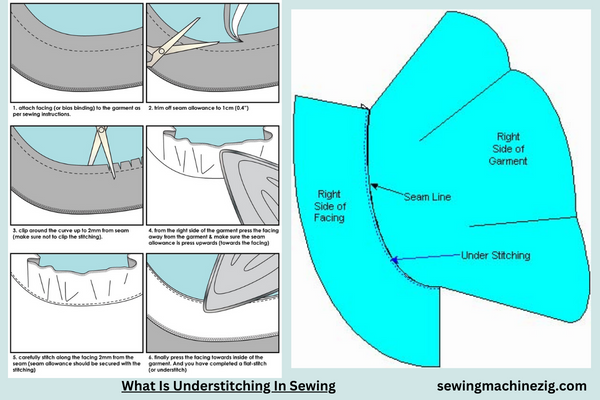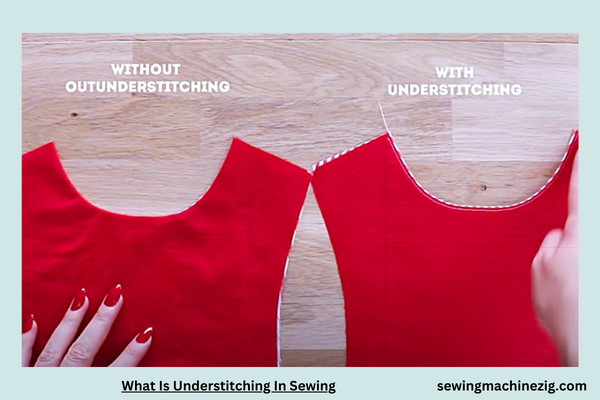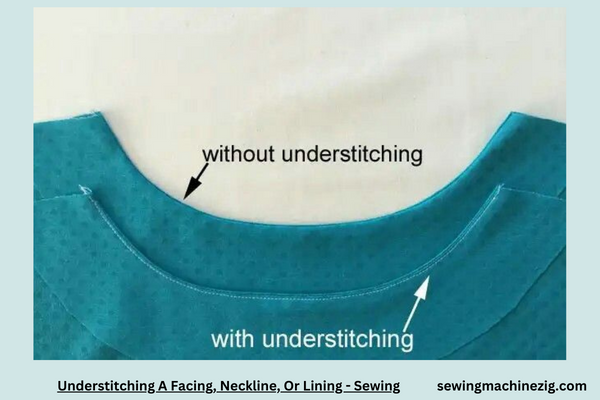
In the intricate world of sewing, mastering techniques like understitching is akin to unlocking a hidden gem. But what exactly is understitching? This fundamental method involves stitching a seam allowance to the facing, preventing edges from rolling outward and enhancing the garment’s structure.
Understanding the nuances of understitching can elevate your sewing projects, imparting a professional touch. In this guide, What Is Understitching In Sewing, we’ll unravel the intricacies of what understitching is in sewing, exploring its importance and the steps to execute this technique flawlessly for garments that exude craftsmanship and finesse.
What Is Understitching In Sewing Detailed Answer

Understanding the intricacies of sewing techniques is vital for creating garments with professional-looking finishes. One such technique, often regarded as a game-changer, is understitching.
In this detailed step-by-step guide, What Is Understitching In Sewing , we’ll unravel what understitching is in sewing and how to master this method for impeccable results.
Step 1: Grasping the Concept of Understitching
Understitching is a sewing technique designed to keep facings or linings from rolling to the garment’s right side. It involves stitching the facing or lining to the seam allowance, ensuring these layers remain tucked inside, providing a clean and polished appearance.
Step 2: Identify When to Use Understitching
Understitching is particularly beneficial when working with garments featuring facings, linings, or curved seams. It is commonly applied to necklines, armholes, and waistlines, preventing these areas from losing their shape over time.
Step 3: Gather Your Materials
Before starting, ensure you have the necessary materials: your garment pieces, a sewing machine, matching thread, and, if needed, a special presser foot for precise stitching.
Step 4: Sew and Grade the Seam
Sew the seam as per your pattern instructions. If applicable, trim or grade the seam allowance to reduce bulk, promoting a smoother finish.
Step 5: Press the Seam Open
Open the seam allowance and press it flat. This step ensures a clean foundation for the next stages of the understitching process.
Step 6: Position the Facing or Lining
Turn the garment right side out and position the facing or lining correctly. Align the seamlines and edges accurately, securing them in place with pins or clips.
Step 7: Understitching Setup on Your Sewing Machine
Set up your sewing machine for understitching by selecting a straight stitch and adjusting the stitch length if necessary. Position the fabric under the presser foot, placing the seam allowance against the facing or lining.
Step 8: Start Understitching
Commence understitching by sewing close to the seamline, typically 1/8 to 1/4 inch away. Ensure the seam allowance stays flat against the facing or lining. Continuous and even stitching is crucial for optimal results.
Step 9: Pivot at Corners
When reaching corners or curves, pivot the fabric with the needle down to maintain a smooth and consistent understitch. This technique ensures the entire facing or lining edge is secure.
Step 10: Final Pressing
After completing the understitching, press the seam again, this time pressing the facing or lining and seam allowance away from the garment. This step sets the stitches and ensures a crisp, professional finish.
Step 11: Evaluate and Adjust
Examine your understitching to ensure it is even and securely holds the facing or lining in place. If needed, make adjustments and practice this technique on scrap fabric before applying it to your final garment.
Incorporating understitching into your sewing repertoire transforms the way your garments look and feel. This essential technique guarantees a polished finish, adding a touch of professionalism to your handmade creations.
By following these step-by-step instructions on What Is Understitching In Sewing and mastering what understitching is in sewing, you’ll elevate your sewing skills and produce garments with impeccable details that stand out in craftsmanship and quality.
How To Sew An Understitch

Sewing an understitch is a technique used to keep facings or linings from rolling to the outside of a garment, ensuring a neat and professional finish. Here’s a straightforward guide on how to sew an understitch:
Prepare Your Fabric:
- After attaching facings or linings to your garment, press the seam allowances toward the facing or lining.
Position the Fabric:
- Lay your fabric with the right side facing up. Ensure the facing or lining is positioned correctly.
Stitch Close to the Edge:
- With the facing or lining facing up, stitch close to the edge, typically about 1/8 to 1/4 inch away. Use a regular straight stitch.
Use the Right Stitch Length:
- Opt for a slightly shorter stitch length, which helps secure the seam allowances and prevents the facing or lining from peeking out.
Backstitch at the Beginning and End:
- Begin stitching a short distance from the edge, backstitch, and then sew all the way to the end. Backstitch again to secure the understitch.
Press the Understitch:
- After sewing the understitch, press the facing or lining and seam allowances away from the garment. This sets the stitches and helps the facing or lining lie flat.
Fold and Press:
- Fold the facing or lining back into its intended position. Press the edge of the garment to ensure a crisp and clean finish.
Topstitch (Optional):
- For additional reinforcement and a polished look, you can choose to topstitch along the seam line from the right side of the fabric. This step is optional and depends on your garment’s design.
Inspect Your Work:
- Check your understitch to ensure it is even and that the facing or lining is securely in place. Make any necessary adjustments.
Sewing an understitch is a simple yet effective technique that contributes to the overall professional appearance of your garment. With practice, you’ll master this skill and use it to achieve clean and well-finished seams in your sewing projects.
Understitching A Facing, Neckline, Or Lining – Sewing

Understitching is a sewing technique used to ensure that facings, necklines, or linings stay tucked inside a garment, providing a neat and polished look. Here’s a simple guide on what is understitching in sewing:
Prepare Your Fabric:
- After attaching a facing, neckline, or lining to your garment, press the seam allowances toward the facing or lining.
Position the Fabric:
- Lay your fabric with the right side facing up, ensuring the facing or lining is in the correct position.
Stitch Close to the Edge:
- Sew a straight stitch close to the edge of the facing or lining, usually about 1/8 to 1/4 inch away. This stitch helps anchor the facing or lining to the inside of the garment.
Use a Shorter Stitch Length:
- Opt for a slightly shorter stitch length, which reinforces the seam and prevents the facing or lining from rolling to the outside.
Backstitch at the Beginning and End:
- Start stitching a short distance from the edge, backstitch, and then sew all the way to the end. Backstitch again to secure the understitching in sewing.
Press the Understitch:
- After sewing, press the facing or lining and seam allowances away from the garment. This sets the stitches and helps the facing or lining lie flat.
Fold and Press:
- Fold the facing or lining back into its intended position. Press the edge of the garment to ensure a crisp and clean finish.
Optional Topstitching:
- If desired, you can topstitch along the seam line from the right side of the fabric for added reinforcement and a polished look. This step is optional and depends on your garment’s design.
Inspect Your Work:
- Check your understitching in sewing to ensure it is even and that the facing or lining is securely in place. Make any necessary adjustments.
What Is Understitching In Sewing? Understitching is a straightforward yet effective technique that contributes to a professional and finished appearance in your sewing projects. With practice, you’ll become adept at understitching, enhancing the overall quality of your garments
Conclusion
To sum up, understanding What Is Understitching In Sewing is crucial for achieving a polished and professional finish in your garments. By sewing a line close to the edge of facings or linings, you secure them in place, preventing them from rolling to the outside.
This simple yet effective technique adds a level of refinement to your sewing projects, ensuring your creations not only look great but also boast a well-crafted interior. Mastering understitching elevates the overall quality of your garments, making your sewing endeavors both skillful and aesthetically pleasing.
FAQS
Q1: What does the term “understitching” mean in sewing?
A1: In sewing, understitching is a technique used to secure facings, linings, or bindings to the inside of a garment. It involves stitching close to the seam line on the facing side to prevent these elements from rolling to the outside.
Q2: Why is understitching important in garment construction?
A2: Understitching is crucial for maintaining a clean and professional look in garments. It helps facings and linings stay in place, ensuring the interior of the garment looks as polished as the exterior.
Q3: When should I use understitching in my sewing projects?
A3: Use understitching whenever you attach facings, linings, or bindings to garments, especially in areas like necklines, armholes, and waistbands. It is particularly beneficial for curved or shaped seams.
Q4: Can I skip understitching and just rely on pressing for a neat finish?
A4: While pressing is essential, understitching provides additional stability, preventing facings and linings from peeking out or becoming visible on the garment’s right side.
Q5: What type of stitches are used in understitching?
A5: Understitching is typically done with a straight stitch. The stitches are sewn close to the seam line on the facing side, securing the facing or lining in place. What Is Understitching In Sewing
Q6: Should I understitch on both sides of a seam?
A6: Understitching is generally done on one side of the seam, typically on the facing side. This ensures that the stitching is concealed on the inside of the garment. What Is Understitching In Sewing



